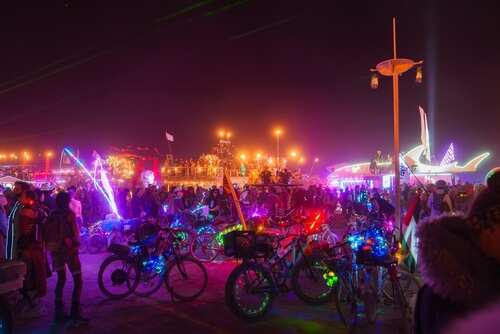Burning Man’s infamous Orgy Dome—once a symbol of radical sexual activism—was obliterated by a freak desert storm, forcing its closure and igniting new debate on the festival’s priorities and risks.
Story Highlights
- A powerful dust storm destroyed Burning Man’s Orgy Dome, canceling all dome events.
- The loss exposes the vulnerability of festival infrastructure and controversial priorities.
- Organizers plan to continue workshops in alternate spaces, reflecting persistence of fringe agendas.
- The incident sparks fresh scrutiny of Burning Man’s culture and its impact on American values.
Dust Storm Destroys Burning Man Orgy Dome, Exposing Festival Risks
On August 26, 2025, a sudden dust storm ripped through Black Rock Desert, Nevada, with wind gusts reaching up to 50 mph. The storm leveled the iconic Orgy Dome at Burning Man, a controversial venue famed for its sex-positive workshops and group encounters. Organizers immediately announced the dome’s destruction and canceled all official events scheduled inside. The loss dealt a significant blow to the festival’s infrastructure, raising hard questions about the wisdom of investing in fringe venues rather than robust safety and preparedness for extreme weather common to the region.
The Orgy Dome, operated by “And Then There’s Only Love” since the early 2000s, has long been a lightning rod for debate. Conservatives have criticized it as emblematic of the radical agendas that have infiltrated American culture—prioritizing sexual experimentation over traditional values and community safety. The dome’s destruction, while disruptive for attendees, exposes the tension between Burning Man’s ethos of radical inclusion and the real-world consequences of neglecting core logistical challenges. Many see the incident as a wake-up call for refocusing on responsibility, resilience, and respect for family values in public spaces.
Organizers Respond: Workshops Continue, But Controversy Remains
Following the dome’s collapse, organizers posted on social media expressing gratitude for the volunteers’ hard work and assuring the community of their safety. They announced plans to relocate some workshops to alternate locations, determined to preserve the festival’s sex-positive education despite the physical setback. This decision underscores the persistence of fringe cultural agendas, even in the face of disaster. While some attendees expressed disappointment at losing a central venue, others voiced relief, citing concerns about the message such spaces send to families and the broader public. The incident has reignited debate over the place of radical experimentation at events that increasingly attract mainstream attention.
Burning Man’s leadership, in collaboration with volunteers, faces growing pressure to reevaluate infrastructure standards and event priorities. The storm’s destruction of major camps and venues, including the Orgy Dome, highlights the need for better weather preparedness and more robust construction. Critics argue that the festival’s focus on alternative lifestyles has come at the expense of basic safety and operational resilience. As organizers weigh their next steps, the conversation is shifting toward core American values—protecting property, ensuring public safety, and fostering environments that support strong families and communities.
Impact on Attendees, Festival Culture, and Broader American Values
The immediate impact of the dome’s destruction is the cancellation of scheduled events and workshops, disappointing attendees seeking the festival’s unique experiences. Yet, the broader implications extend beyond logistics. The incident challenges Burning Man to prioritize infrastructure resilience and reconsider the place of radical cultural experiments in American life. Conservatives see the loss as an opportunity to advocate for realignment with traditional values, limited government involvement in regulating controversial spaces, and a renewed focus on protecting the nation’s moral fabric. The disaster may prompt organizers to rethink how—and if—such venues should be rebuilt, and whether their continued presence aligns with the festival’s growing mainstream footprint.
LEGALLY, THIS IS AN ACT OF GOD… “Burning Man Orgy Dome Destroyed By Freak Storm”… https://t.co/WOoxW8AnGR pic.twitter.com/iS7UFK7vh1
— Brian Harrod (@GetTheDailyDirt) August 26, 2025
Expert perspectives from event infrastructure analysts highlight the vulnerability of temporary structures in harsh desert environments. Community leaders in the sex-positive movement express hope for rebuilding, but also acknowledge the symbolic loss. Scholars note that the Orgy Dome’s destruction is more than a logistical setback—it is a cultural moment that forces a reckoning over the festival’s priorities and their impact on society. The event has drawn consistent coverage from mainstream outlets, with no major contradictions in the timeline or facts. As Burning Man moves forward, the debate over the future of controversial venues and the values they represent will shape both policy and public perception in the years ahead.
Sources:
Burning Man 2025 Dust Storm Destroys Camps in Nevada’s Black Rock Desert
Click this link for the original source of this article.
Author: Editor
This content is courtesy of, and owned and copyrighted by, https://libertynewsalerts.com and its author. This content is made available by use of the public RSS feed offered by the host site and is used for educational purposes only. If you are the author or represent the host site and would like this content removed now and in the future, please contact USSANews.com using the email address in the Contact page found in the website menu.





